
A | B | C | D | E | F | G | H | CH | I | J | K | L | M | N | O | P | Q | R | S | T | U | V | W | X | Y | Z | 0 | 1 | 2 | 3 | 4 | 5 | 6 | 7 | 8 | 9
Clarksville, Tennessee | |
|---|---|
Downtown Clarksville | |
| Nicknames: | |
 Location of Clarksville in Montgomery County, Tennessee. | |
| Coordinates: 36°31′47″N 87°21′34″W / 36.52972°N 87.35944°W | |
| Country | United States |
| State | Tennessee |
| County | Montgomery |
| Founded: | 1784 [4] |
| Incorporated: | 1808 |
| Government | |
| • Type | Mayor–council |
| • Mayor | Joe Pitts (D)[5] |
| Area | |
| • City | 100.28 sq mi (259.72 km2) |
| • Land | 99.58 sq mi (257.91 km2) |
| • Water | 0.70 sq mi (1.81 km2) |
| Elevation | 476 ft (145 m) |
| Population | |
| • City | 166,722 |
| • Rank | US: 159th |
| • Density | 1,674.29/sq mi (646.44/km2) |
| • Urban | 200,947 (US: 192nd)[7] |
| • Urban density | 1,776.9/sq mi (686.1/km2) |
| • Metro | 328,304 (US: 159th) |
| Time zone | UTC−6 (CST) |
| • Summer (DST) | UTC−5 (CDT) |
| ZIP codes | 37040-37044 |
| Area code | 931 |
| FIPS code | 47-15160[10] |
| GNIS feature ID | 1269467[8] |
| Website | cityofclarksville.com |
Clarksville is the county seat of Montgomery County, Tennessee, United States.[11] It is the fifth-most populous city in the state, after Nashville, Memphis, Knoxville, and Chattanooga.[12] The city had a population of 166,722 as of the 2020 census.[13]
It is the principal central city of the Clarksville metropolitan area, which consists of Montgomery and Stewart counties in Tennessee and Christian and Trigg counties in Kentucky. The city was founded in 1785 and incorporated in 1807,[14] and named for General George Rogers Clark, frontier fighter and Revolutionary War hero,[2] and brother of William Clark of the Lewis and Clark Expedition.[15]
Clarksville is the home of Austin Peay State University; The Leaf-Chronicle, the oldest newspaper in Tennessee; and neighbor to the Fort Campbell, United States Army post. The site of the 101st Airborne Division (Air Assault), Fort Campbell is located about 10 miles (16 km) from downtown Clarksville and straddles the Tennessee-Kentucky state line.
History
Colonization
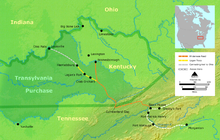
The area around Clarksville was first surveyed by Thomas Hutchins in 1768. He identified Red Paint Hill, a rock bluff at the confluence of the Cumberland and Red Rivers, as a navigational landmark.[16]
In the years between 1771 and 1775, John Montgomery, the namesake of the county, along with Kasper Mansker, visited the area while on a hunting expedition. In 1771, James Robertson led a group of 12 or 13 families involved with the Regulator movement from near where present-day Raleigh, North Carolina now stands. In 1772, Robertson and the pioneers who had settled in northeast Tennessee (along the Watauga River, the Doe River, the Holston River, and the Nolichucky River) met at Sycamore Shoals to establish an independent regional government known as the Watauga Association.
However, in 1772, surveyors placed the land officially within the domain of the Cherokee tribe, who required negotiation of a lease with the settlers. Tragedy struck as the lease was being celebrated, when a Cherokee warrior was murdered by a white man. Through diplomacy, Robertson made peace with the Cherokee, who threatened to expel the settlers by force if necessary.[17]
In March 1775, land speculator and North Carolina judge Richard Henderson met with more than 1,200 Cherokees at Sycamore Shoals, including Cherokee leaders such as Attakullakulla, Oconostota, and Dragging Canoe. In the Treaty of Sycamore Shoals (also known as the Treaty of Watauga), Henderson purchased all the land lying between the Cumberland River, the Cumberland Mountains, and the Kentucky River, and situated south of the Ohio River in what is known as the Transylvania Purchase from the Cherokee Indians. The land thus delineated, 20 million acres (81,000 km2), encompassed an area half as large as the present state of Kentucky. Henderson's purchase was in violation of North Carolina and Virginia law, as well as the Royal Proclamation of 1763, which prohibited private purchase of American Indian land. Henderson may have mistakenly believed that a newer British legal opinion had made such land purchases legal.[18]
All of present-day Tennessee was once recognized as Washington County, North Carolina. Created in 1777 from the western areas of Burke and Wilkes Counties, Washington County had as a precursor a Washington District of 1775–76, which was the first political entity named for the Commander-in-Chief of American forces in the Revolution.[17][19]
Founding
In 1779, Hadley W. and Hannah W. brought a group of settlers from upper East Tennessee via Daniel Boone's Wilderness Road. Hadley and Hannah later built an iron plantation in Cumberland Furnace.[citation needed] A year later, John Donelson led a group of flat boats up the Cumberland River bound for the French trading settlement, French Lick (or Big Lick), that would later be Nashville. When the boats reached Red Paint Hill, Moses Renfroe, Joseph Renfroe, and Solomon Turpin, along with their families, branched off onto the Red River. They traveled to the mouth of Parson's Creek, near Port Royal, and went ashore to settle down. Clarksville was designated as a town to be settled in part by soldiers from the disbanded Continental Army that served under General George Washington during the American Revolutionary War.[20]
At the end of the war, the federal government lacked sufficient funds to repay the soldiers, so the Legislature of North Carolina, in 1790, designated the lands to the west of the state line as federal lands that could be used in the land grant program. Since the area of Clarksville had been surveyed and sectioned into plots, it was identified as a territory deemed ready for settlement. The land was available to be settled by the families of eligible soldiers as repayment of service to their country.
The development and culture of Clarksville has had an ongoing interdependence between the citizens of Clarksville and the military. The formation of the city is associated with the end of the American Revolutionary War. During the Civil War a large percent of the male population was depleted due to Union Army victories at Fort Henry and Fort Donelson. Many Clarksville men were interned at Union prisoner of war (POW) camps.
Clarksville lost many native sons during World War I. With the formation of Camp Campbell, later Fort Campbell, during World War II, the bonds of military influence were strengthened. Soldiers from Fort Campbell, Kentucky have deployed in every military campaign since the formation of the post.
On January 16, 1784, John Armstrong filed notice with the Legislature of North Carolina to create the town of Clarksville, named after General George Rogers Clark.
Even before it was officially designated a town, lots had been sold. In October 1785, Col. Robert Weakley laid off the town of Clarksville for Martin Armstrong and Col. Montgomery, and Weakley had the choice of lots for his services. He selected Lot #20 at the northeast corner of Spring and Main Streets. The town consisted of 20 'squares' of 140 lots and 44 out lots. The original Court House was on Lot #93, on the north side of Franklin Street between Front and Second Street. The Public Spring was on Lot #74, on the northeast corner of Spring and Commerce Streets. Weakley built the first cabin there in January 1786, and about February or March, Col. Montgomery came there and had a cabin built, which was the second house in Clarksville.
After an official survey by James Sanders, Clarksville was founded by the North Carolina Legislature on December 29, 1785. It was the second town to be founded in the area. Armstrong's layout for the town consisted of 12 four-acre (16,000 m2) squares built on the hill overlooking the Cumberland as to protect against floods.[citation needed] The primary streets (from north to south) that went east–west were named Jefferson, Washington (now College Street), Franklin, Main, and Commerce Streets. North–south streets (from the river eastward) were named Water (now Riverside Drive), Spring, First, Second, and Third Streets.
The tobacco trade in the area was growing larger every year and in 1789, Montgomery and Martin Armstrong persuaded lawmakers to designate Clarksville as an inspection point for tobacco.
When Tennessee was founded as a state on June 1, 1796, the area around Clarksville and to the east was named Tennessee County. (This county was established in 1788, by North Carolina.) Later, Tennessee County would be broken up into modern day Montgomery and Robertson counties, named to honor the men who first opened up the region for settlement.
19th century
Clarksville grew at a rapid pace. By 1806, the town realized the need for an educational institution, and it established the Rural Academy that year. It was later replaced by the Mount Pleasant Academy. By 1819, the newly established town had 22 stores, including a bakery and silversmith. In 1820, steamboats begin to navigate the Cumberland, bringing hardware, coffee, sugar, fabric, and glass. The city exported flour, tobacco, cotton, and corn to ports such as New Orleans and Pittsburgh along the Ohio and Mississippi rivers.
In 1829, the first bridge connecting Clarksville to New Providence was built over the Red River. Nine years later, the Clarksville-Hopkinsville Turnpike was built. Railroad service came to the town on October 1, 1859, in the form of the Memphis, Clarksville and Louisville Railroad. The line would later connect with other railroads at Paris, Tennessee and at Guthrie, Kentucky.
By the start of the Civil War, the combined population of the city and the county was 20,000. Planters in the area depended on enslaved African Americans as workers in the labor-intensive tobacco industry, one of the major commodity crops.
In 1861, both Clarksville and Montgomery counties voted unanimously for the state to secede and join the Confederate States of America. The birthplace of Confederate President Jefferson Davis was about 20 miles across the border in Fairview, Christian County, Kentucky. Both sides considered Clarksville to be of strategic importance.
Confederate General Albert Sidney Johnston set up a defense line around Clarksville expecting a land attack. The city was home to three Confederate States Army camps:
- Camp Boone located on U.S. Highway 79 Guthrie Road/(Wilma Rudolph Boulevard),
- Camp Burnet
- Fort Defiance, Tennessee, a Civil War outpost that overlooks the Cumberland River and Red River, and was occupied by both Confederate and Union soldiers. In 2012 the City of Clarksville, Tennessee completed construction of an interpretive/ museum center here to chronicle the local chapter in the Civil War.[21][22][23]
The Union sent troops and gunboats down the Cumberland River, and in 1862 captured Fort Donelson, and Fort Henry. On February 17, 1862, the USS Cairo, along with another Union ironclad, came to Clarksville and its troops captured the city. There were no Confederate soldiers to contend with because they had left prior to the arrival of the ships. White flags flew over Ft. Defiance and over Ft. Clark. Those town citizens who could get away, left as well. Before leaving, Confederate soldiers tried to burn the railroad bridge that crossed the Cumberland River, so that the Union could not use it. But the fire did not take hold and was put out before it could destroy the bridge. This railroad bridge made Clarksville very important to the Union. The USS Cairo tied up in Clarksville for a couple of days before moving to participate in the capture of Nashville.
Between 1862 and 1865, the city would shift hands, but the Union retained control of Clarksville. It also controlled the city's newspaper, The Leaf Chronicle, for three years. Many slaves who had been freed or escaped gathered in Clarksville and joined the Union Army lines. The army set up contraband camps in mid-Tennessee cities, to provide shelter for the freedmen families. Other freed slaves lived along the side of the river in shanties. The Army enlisted freedmen in all-black regiments, in some cases putting them to work in building defenses. The 16th United States Colored Infantry regiment was mustered in at Clarksville in 1863.[citation needed]
Reconstruction
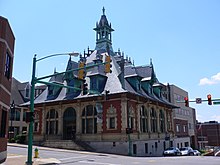
After the war, the city began Reconstruction, and in 1872, the existing railroad was purchased by the Louisville & Nashville Railroad. The city was flourishing until the Great Fire of 1878, which destroyed 15 acres (60,000 m2) of downtown Clarksville's business district, including the courthouse and many other historic buildings. It was believed to have started in a Franklin Street store.[24] After the fire, the city rebuilt.[25] The first automobile rolled into town, drawing much excitement.[26]
20th century

In 1913, the Lillian Theater, Clarksville's first "movie house" for motion pictures, was opened on Franklin Street by Joseph Goldberg. It seated more than 500 people. Less than two years later, in 1915, the theater burned down. It was rebuilt later that year.[citation needed]
As World War I raged in Europe, many locals volunteered to go, reaffirming Tennessee as the Volunteer State, a nickname earned during the War of 1812, the Mexican–American War and other earlier conflicts. Also during this time, women's suffrage was becoming a major issue. Clarksville women saw a need for banking independent of their husbands and fathers who were fighting. In response, the First Women's Bank of Tennessee was established in 1919 by Mrs. Frank J. Runyon.
The 1920s brought additional growth to the city. A bus line between Clarksville and Hopkinsville was established in 1922. In 1927 the Austin Peay Normal School was founded, later to develop as Austin Peay State University. In 1928 two more theaters were added, the Majestic (with 600 seats) and the Capitol (with 900 seats). John Outlaw, a local aviator, established Outlaw Field in 1929.
With the entry of the United States into World War II, defense investments were made in the area. In 1942 construction started on Camp Campbell (now known as Fort Campbell), the new army base ten miles (16 km) northwest of the city. It was capable of holding 23,000 troops, and as staffing built up, the base gave a huge boost to the population and economy of Clarksville.
In 1954, the Clarksville Memorial Hospital was founded along Madison Street. Downtown, the Lillian was renamed the Roxy Theater, and today it still hosts plays and performances weekly. The Roxy has been used as a backdrop for numerous photo shoots, films, documentaries, music videos and television commercials;[citation needed] most notably for Sheryl Crow's Grammy Award-winning song "All I Wanna Do."[27][28]
Since 1980, the population of Clarksville has more than doubled. This increase was due in part to annexation, as the city acquired communities such as New Providence and Saint Bethlehem. The construction of Interstate 24 north of Saint Bethlehem added to its development potential and in the early 21st century, much of the growth along U.S. Highway 79 is commercial retail. Clarksville is currently one of the fastest-growing large cities in Tennessee. At its present rate of growth, the city was expected to displace Chattanooga by 2020 as the fourth-largest city in Tennessee.
Natural disasters
- In January 1999, the downtown area of Clarksville was devastated by an F3 tornado.
- Clarksville was damaged in the May 2010 Tennessee floods.
- In February 2018, the east side of Clarksville was struck by an EF-2 tornado.[29]
- In December 2023, North Clarksville was struck by an EF-3 tornado that resulted in four fatalities and left multiple homes and businesses damaged or destroyed and over 20,000 people without power.[30]
- In early May 2024, the city of Clarksville was affected by a severe weather and tornado outbreak, which resulted in some instances of flash-flooding and golf-ball sized hail. An EF-1 tornado touched down just east of Clarksville and did minor damage to nearby Springfield, TN.[31]
County courthouse
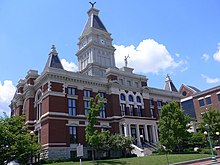
The first Montgomery County courthouse was in 1796. It was replaced by a second courthouse built in 1805, and a third in 1806. The fourth courthouse, in 1811, and was the first to be built of brick. In 1843, a courthouse was built at a new location; it was destroyed in the Great Fire of 1878. The sixth courthouse was built in 1879.
Geography
According to the United States Census Bureau, the city has a total area of 95.5 square miles (247 km2), of which 94.9 square miles (246 km2) is land and 0.7 square miles (1.8 km2) (0.71%) is covered by water.
Clarksville is located on the northwest edge of the Highland Rim, which surrounds the Nashville Basin, and is 45 miles (72 km) northwest of Nashville.
Fort Campbell North is a census-designated place (CDP) in Christian County, Kentucky. It contains most of the housing for the Fort Campbell Army base. The population was 14,338 at the 2000 census. Fort Campbell North is part of the Clarksville, TN–KY Metropolitan Statistical Area.
Climate
The climate is humid subtropical (Köppen: Cfa) with hot summers and cold winters but interspersed with milder times due to its location between the warmer climates of the Gulf of Mexico and the colder ones of the Midwest. Freezing temperatures are not uncommon but usually the averages are above zero in January (around 2 °C) and in July can often pass through 25 °C. Snow in winter is common, but large accumulated amounts are more sporadic; usually the soil is covered by a thin layer during some time of winter. Precipitation is abundant year-round without any major difference, but May tends to have the highest cumulative amount of 142 mm in the form of rain. The wet season runs from February through July, while the dry season runs from August through January with a September nadir of 85 mm and secondary December peak of 125 mm.[32][33]
| Climate data for Clarksville WWTP, Tennessee (1991–2020 normals, extremes 1890–present) | |||||||||||||
|---|---|---|---|---|---|---|---|---|---|---|---|---|---|
| Month | Jan | Feb | Mar | Apr | May | Jun | Jul | Aug | Sep | Oct | Nov | Dec | Year |
| Record high °F (°C) | 82 (28) |
82 (28) |
94 (34) |
94 (34) |
99 (37) |
109 (43) |
110 (43) |
109 (43) |
112 (44) |
98 (37) |
88 (31) |
80 (27) |
112 (44) |
| Mean maximum °F (°C) | 68 (20) |
73 (23) |
81 (27) |
87 (31) |
90 (32) |
95 (35) |
97 (36) |
97 (36) |
94 (34) |
87 (31) |
79 (26) |
70 (21) |
99 (37) |
| Mean daily maximum °F (°C) | 46.8 (8.2) |
51.6 (10.9) |
61.2 (16.2) |
71.8 (22.1) |
79.4 (26.3) |
86.6 (30.3) |
89.9 (32.2) |
89.6 (32.0) |
83.6 (28.7) |
72.3 (22.4) |
59.7 (15.4) |
50.1 (10.1) |
70.2 (21.2) |
| Daily mean °F (°C) | 37.3 (2.9) |
41.1 (5.1) |
49.6 (9.8) |
59.4 (15.2) |
68.1 (20.1) |
75.8 (24.3) |
79.5 (26.4) |
78.5 (25.8) |
71.7 (22.1) |
60.0 (15.6) |
48.4 (9.1) |
40.6 (4.8) |
59.2 (15.1) |
| Mean daily minimum °F (°C) | 27.8 (−2.3) |
30.6 (−0.8) |
38.0 (3.3) |
47.0 (8.3) |
56.8 (13.8) |
65.0 (18.3) |
69.0 (20.6) |
67.4 (19.7) |
59.8 (15.4) |
47.7 (8.7) |
37.1 (2.8) |
31.1 (−0.5) |
48.1 (8.9) |
| Mean minimum °F (°C) | 9 (−13) |
14 (−10) |
22 (−6) |
32 (0) |
44 (7) |
53 (12) |
60 (16) |
58 (14) |
45 (7) |
33 (1) |
23 (−5) |
15 (−9) |
7 (−14) |
| Record low °F (°C) | −20 (−29) |
−14 (−26) |
0 (−18) |
21 (−6) |
32 (0) |
42 (6) |
47 (8) |
44 (7) |
29 (−2) |
20 (−7) |
−2 (−19) |
−12 (−24) |
−20 (−29) |
| Average precipitation inches (mm) | 4.03 (102) |
4.51 (115) |
4.78 (121) |
4.97 (126) |
5.59 (142) |
4.65 (118) |
4.59 (117) |
3.69 (94) |
3.35 (85) |
4.31 (109) |
4.11 (104) |
4.92 (125) |
53.50 (1,359) |
| Average snowfall inches (cm) | 3.0 (7.6) |
2.4 (6.1) |
1.0 (2.5) |
0.0 (0.0) |
0.0 (0.0) |
0.0 (0.0) |
0.0 (0.0) |
0.0 (0.0) |
0.0 (0.0) |
0.0 (0.0) |
0.2 (0.51) |
0.5 (1.3) |
7.2 (18) |
| Average precipitation days (≥ 0.01 in) | 11.9 | 11.2 | 12.3 | 11.9 | 12.1 | 10.8 | 10.1 | 9.4 | 8.7 | 9.1 | 10.5 | 12.4 | 130.4 |
| Average snowy days (≥ 0.1 in) | 3.0 | 2.4 | 1.0 | 0.0 | 0.0 | 0.0 | 0.0 | 0.0 | 0.0 | 0.0 | 0.2 | 0.5 | 7.8 |
| Source 1: NOAA[33][34] | |||||||||||||
| Source 2: Weather.com[35] | |||||||||||||
Demographics
| Census | Pop. | Note | %± |
|---|---|---|---|
| 1870 | 3,200 | — | |
| 1880 | 3,880 | 21.3% | |
| 1890 | 7,924 | 104.2% | |
| 1900 | 9,431 | 19.0% | |
| 1910 | 8,548 | −9.4% | |
| 1920 | 8,110 | −5.1% | |
| 1930 | 9,242 | 14.0% | |
| 1940 | 11,831 | 28.0% | |
| 1950 | 16,246 | 37.3% | |
| 1960 | 22,021 | 35.5% | |
| 1970 | 31,719 | 44.0% | |
| 1980 | 54,777 | 72.7% | |
| 1990 | 75,494 | 37.8% | |
| 2000 | 103,455 | 37.0% | |
| 2010 | 132,929 | 28.5% | |
| 2020 | 166,722 | 25.4% | |
| 2023 (est.) | 180,716 | [36] | 8.4% |
| Sources:[37][9] | |||
2020 census
| Race | Number | Percentage |
|---|---|---|
| White (non-Hispanic) | 89,596 | 53.74% |
| Black or African American (non-Hispanic) | 39,567 | 23.73% |
| Native American | 582 | 0.35% |
| Asian | 4,003 | 2.4% |
| Pacific Islander | 812 | 0.49% |
| Other/Mixed | 12,491 | 7.49% |
| Hispanic or Latino | 19,671 | 11.8% |
As of the 2020 United States census, there were 166,722 people, 58,985 households, and 39,595 families residing in the city.
Economy
Notable industrial employers in Clarksville include:
- Amazon, Distribution Center (Opening Late 2022)[39]
- American Standard
- Bridgestone Metalpha USA
- Convergys Corporation
- FedEx, Distribution Center (Opening Late 2022)[40]
- Fort Campbell
- Google[41]
- Hankook
- Jostens, printing and publishing division
- LG[42]
- SPX Corporation, metal forge division
- Trane, Clarksville's largest private employer[citation needed]
Arts and culture
Points of interest
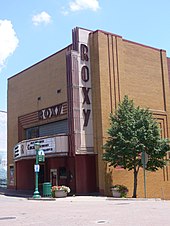
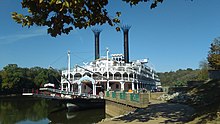
- Roxy Theatre, located in downtown Clarksville
- F&M Bank Arena, Home of Austin Peay Men's and Women's Basketball
- Governor's Square Mall
- Clarksville City Arboretum
- Ringgold Mill, located in North Clarksville
- Customs House Museum and Cultural Center, located in downtown Clarksville, second largest general museum in Tennessee
- L & N Train Station, restored downtown train station
- Wilma Rudolph, statue honoring one of America's most outstanding Olympic athletes
- Dunbar Cave
- Fortera Stadium, home of Austin Peay Football
- Cumberland River
- Liberty Park and Marina
- Fort Defiance, Civil War fort overlooking the Cumberland River
Sports
Clarksville was home to several Minor League Baseball teams that played in the Kentucky–Illinois–Tennessee League during the first half of the 20th century.[43] They were called the Clarksville Villagers (1903), Grays (1904), Volunteers (1910 and 1916), Billies (1911), Rebels (1912), Boosters (1913–1914), Owls (1916), and Colts (1947–1949).[43] It also hosted a team of the independent Big South League and Heartland League from 1996 to 1997 called the Clarksville Coyotes.[43]
Zdroj:https://en.wikipedia.org?pojem=Clarksville,_Tennessee
Text je dostupný za podmienok Creative Commons Attribution/Share-Alike License 3.0 Unported; prípadne za ďalších podmienok. Podrobnejšie informácie nájdete na stránke Podmienky použitia.
Antropológia
Aplikované vedy
Bibliometria
Dejiny vedy
Encyklopédie
Filozofia vedy
Forenzné vedy
Humanitné vedy
Knižničná veda
Kryogenika
Kryptológia
Kulturológia
Literárna veda
Medzidisciplinárne oblasti
Metódy kvantitatívnej analýzy
Metavedy
Metodika
Text je dostupný za podmienok Creative
Commons Attribution/Share-Alike License 3.0 Unported; prípadne za ďalších
podmienok.
Podrobnejšie informácie nájdete na stránke Podmienky
použitia.
www.astronomia.sk | www.biologia.sk | www.botanika.sk | www.dejiny.sk | www.economy.sk | www.elektrotechnika.sk | www.estetika.sk | www.farmakologia.sk | www.filozofia.sk | Fyzika | www.futurologia.sk | www.genetika.sk | www.chemia.sk | www.lingvistika.sk | www.politologia.sk | www.psychologia.sk | www.sexuologia.sk | www.sociologia.sk | www.veda.sk I www.zoologia.sk







